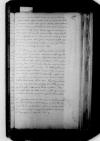List #5756
Alfonso de VALDÉS do Ioannes DANTISCUSs.l., [1528-09 – 1528-12-17?]
Regest polski: Valdes zachwyca się wierszami, którymi obdarowuje go stale Dantyszek. Zgadza się z opinią Dantyszka, iż Cato [Lodewijk van Praet] ma nieco nieokrzesany umysł; żartobliwie wymawia Dantyszkowi, iż trwoni swój talent, tworząc na ten temat wiersze. Zawiadamia, że list, o który Dantyszek prosił, czeka już na podpis cesarza. Valdes ucieszy się z wizyty Dantyszka albo sam się do niego wybierze.
Rękopiśmienne podstawy źródłowe:
Pomocnicze podstawy źródłowe:
Publikacje:
| ||||||||||||||||||||
Tekst + aparat krytyczny + komentarzZwykły tekstTekst + komentarzTekst + aparat krytyczny
Salutem.
Itane tuis me subinde deliciis cf.
ms 1 2 isto⌈istocprint 1 istoc,
ms 1 2 isto⌉ pectore, quam a montibus fluunt flumina? Emoriar, ni id ipsum, quod cf.
print 1 ni fallor⌈(ni fallor)ms 1 2 (ni fallor),
print 1 ni fallor⌉, agreste. Sed ms 1 2 nonne,
print 1 ne⌈nonnems 1 2 nonne,
print 1 ne⌉ tu nimium prodigus es, qui tuas delicias sic effundas, vel, ms 1 2 (si dicere fas est),
print 1 si dicere fas est⌈(si dicere fas est)ms 1 2 (si dicere fas est),
print 1 si dicere fas est⌉, stultus,
cf. Vulg. Mt 7.6 Nolite dare sanctum canibus: neque mittatis margaritas vestras ante porcos, ne forte conculcent eas pedibus suis, et conversi dirumpant vos ⌊qui margaritas
print 1 proicias,
ms 1 2 proicis⌈proiciasprint 1 proicias,
ms 1 2 proicis⌉
porciscf. Vulg. Mt 7.6 Nolite dare sanctum canibus: neque mittatis margaritas vestras ante porcos, ne forte conculcent eas pedibus suis, et conversi dirumpant vos ⌋. Litterae, quas a me petiisti, print 1 confectae,
ms 1 2 infectae⌈confectaeprint 1 confectae,
ms 1 2 infectae⌉ sunt. Curabimus, ut subscribantur a
Vale.

 BK 222, No. 47, p. 188
BK 222, No. 47, p. 188